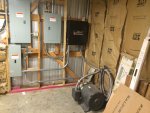Jkr3497
Member
- Location
- Omaha, Nebraska
I have a phase converter I have installed. Per the manufactures installation manual the rotor will produce up to 150 amps. The manual says to feed the unit with 1 phase 225 amps. I am doing so with a 4/0 cu thhn. It says the 3phase output should be a 1/0. what is protecting the 1/0 if I am feeding the whole setup with 225amps? I am feeding a main lug 3 phase panel. My inspector stopped and looked at it, he says I need a 150 main breaker in the panel. Is he right or do I have an argument? In my eyes I am feeding the whole setup with the 250% it should have.
 :?
:?
 :?
:?
